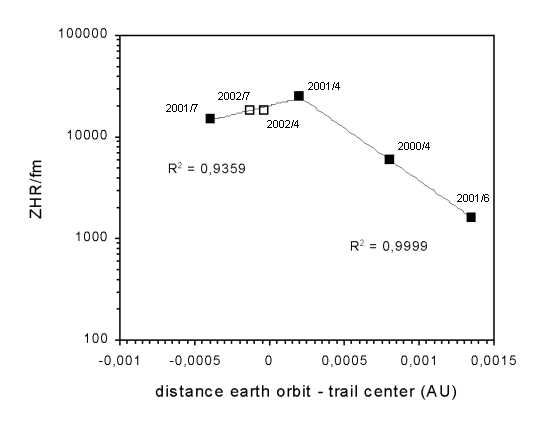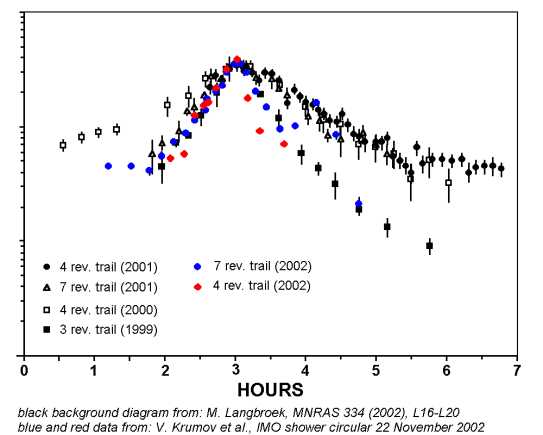
2002 Leonids: some thoughts (followed by a personal account of the shower)
Marco Langbroek, Dutch Meteor Society (DMS)
abstract - preliminary IMO results of the 2002 Leonids (Krumov et al. 2002) are compared to my earlier predictions in the MNRAS of August 2002 (Langbroek 2002). Following this, a personal account of the shower as seen from Spain is given.
1. Introduction
In the August 2002 issue of the Monthly Notices of the Royal Astronomical Society, I published a paper with upper and lower limits to expected Leonid rates for 2002 (M. Langbroek: Observational evidence for 'punctuated equilibria' in the evolution of Leonid dust trail widths and implications for meteor rate predictions. MNRAS 334 (2002), L16-L20) and what seemed to be patterning in the width evolution of Leonid dust trails.
Here I compare these with actual 2002 results as gathered by IMO (Krumov et al. 2002) and from this come to some conclusions with regard to my earlier ideas. I also give a narrative account of my own observing experiences with regard to the 7 revolutions trail as seen from southeast Spain.
2.1 The ZHR predictions

The lower boundaries for the ZHR predictions from my paper compare well to what was actually observed. The preliminary IMO-values for the 4 and 7 revolution peak occurrences of November 19, 2002 (Krumov et al. 2002), plot well into figure 6 of my paper (Langbroek 2002) indicating that for trails in this range of delta a(0) the ZHR indeed appears to be an approximation of the miss distance rE-rD against ZHR/fm (see Langbroek 2002). See also the improved diagram above (ZHR data from Krumov et al. 2002, depicted as open squares, have been scaled to the DMS ZHR level as indicated in Langbroek 2002, note 1. Other data in the diagram are from Langbroek 2002). The diagram indicates that for trails 4 to 7 revolutions old, the trail center of dust density is located some +0.0002 AU from the calculated dust trail centers (see discussion in Langbroek 2002).
2.2 Trail shapes

The results of 2002 appear to falsify my concept of 'punctuated equilibria' in dust trail width evolution, as the descending branches of both the 2002/4 and 2002/7 revolution peaks do not match the descending branches of the 4-7 revolution peaks from 2000-2001 in shape. Interesting to note is that again the ascending branches of the 2002 peaks and all previous peaks of 1999-2001 are highly similar (with regard to the deviating 2000/4 trail; see discusion in Langbroek 2002). But the descending branches vary. What is causing the latter variation is not clear. It does not appear to be related to a punctuated evolution of trail widths with age (cf. Langbroek 2002); but neither is it related to the miss distance rD-rE with the trails (cf. Jenniskens et al. 2000), or a clear function of trail age (Lyytinen & Van Flandern 2000; McNaught & Asher 1999). Neither does it appear to relate to delta a(0).
2.3 Conclusions
The rates of Leonid dust trail occurrences of 4-7 revolutions old, indeed appear to be predictable as a relation between the miss-distance rD-rE and ZHR/fm, as I pointed out earlier (Langbroek 2002). Following the discussion in Langbroek (2002), the dust trail density center location appears to differ by some 0.0002 AU from the calculated positions (those of Lyytinen & Van Flandern 2000; Asher & McNaught 1999).
The predictions with regard to peak shapes and hence Leonid dust trail evolution patterning, however appear to have been falsified. Interesting to note is that while all ascending branches are highly similar in shape, there is variation in the descending branches. The latter remaines unexplained.
3. Observations from the Valle de Rodalquilar, southeast Spain
These year's Leonids were most unusual for me. This campaign would mark for me and my friends the last big Leonid campaign after 7 years of dedicated chasing of Leonid peaks all over the globe, and thus the end of a meteor era highly dominated by the Leonids. It started in 1995 with a combined Leonid/alpha Monocerotid campaign in Spain; followed by a last-minute 'crash' expedition by car to northern France in 1996 (see results in Langbroek 1999); a campaign in the Dutch-German border area in 1997; the large expedition to the deserts of Qinghai, Northwest China in 1998 (the first Sino-Dutch Leonid expedition); a campaign from France and Spain in 1999 (with my first true Leonid storm observations, from Xalos near Valencia); a last minute 'crash' by plane to south Portugal in 2000; another expedition to Arizona, USA, in 2001 (where I observed my second Leonid storm); and now finally observations from the southeast corner of Spain again, coming full circle to the series started in 1995. This was the first time however that I did not come home with a good set of visual data, as cirrus clouds intervened this time, although we did see the storm this year.
What influenced this year's campaign for me foremost however, was a very tragic personal event. My father died just 2 weeks prior to the Leonids. The trip this year for me therefore was more in search of peace of mind, rather than for chasing my third Leonid storm. I did not get into proper Leonid mood at all untill the afternoon of the 18th.
Initially, we had a location with a rented home close to Granada as part of a large network of several visual/photo/video stations initiated by the Dutch Meteor Society. A very untimely front with a massive cloud cover moved over much of Iberia however those days, so we were forced to move to the extreme southeast corner of Spain on the day of the18th. Even there, prospects were not too good and finally we would be confronted with cirrus clouds that night.
But yes, we did see the Leonid storm peak (my third Leonid storm), but through the cirrus. The moon was surrounded by a full halo at several times that night. The cirrus cover was too serious and conditions too variable to allow meaningfull visual data gathering, but at least we did see meteors. I did do some counts anyway, but without trying to estimate Lm's or cloud cover % (as this was simply impossible). Even through thick cirrus I counted up to 8-10 meteors/minute during the peak, with one count of 18/minute but this was partly due to a short spectacular one second flurry similar to the one filmed by the Japanese a few years ago. Without clouds and moonlight, observed rates evidently would have been very high and probably similar to what we saw from Arizona in 2001 at least. As a non-scientific estimate I feel that the ZHR must have been at least 2500 and possibly higher given what we observed. Indeed, such is indicated by the preliminary results gathered by IMO (Krumov et al. 2002). As experienced by us, activity rose very quickly from almost nill to a peak somewhere near 4:10 or 4:15 UTC and then died down again gradually. Saw a few nice fireballs (2 or 3 particularly spectacular, up to magnitide -8) and enduring persistent trains, a few of which Romke filmed on video. My impression was however that meteors on average were less bright than last year, but this impression might have been influenced by the observing conditions. I do hope the video does yield some multistation data, as we filmed quite some meteors nothwithstanding the cirrus and our other stations were active under similar conditions too, spread along the southeast coast of Spain (all our stations, including us, had to move due to the advancing depression). My companions at Rodalquilar were Carl Johannink, Romke Schievink, Casper ter Kuile, and Rita Verhoef by the way.
We had a particularly scenic observing locality this time. The small Valle de Rodalquilar near Cabo de Gata has not yet been discovered by abundant tourists, and the little valley is distinctly non-European in character. Instead, you might think you are in North Africa. It is a beatifull arid landscape surrounded by low rocky mountain ridges; a semi-desert with Agave, some shrubs and the odd little tree and palmtree. Rodalquilar is a small quiet village. A flock of sheep and it's herdsman wanders around the valley. At night, there is almost no artificial illumination. A kilometer or two outside the village is a smaller hamlet consisting of a few occupied houses and a few ruine houses. A few hundred yards more to the east is an XI century (Moorish) fortified tower ruin, now used as a sheep-pen, with a scenic and colourfull rock outcrop at a few tens of yards, and a clump of palm trees making this look quite like a little oasis. This is where we set up our observing equipment. A walk of some 300-400 yards along a winding non-paved dustroad through a beatifull landscape (moonlit during our observing night) then finally brings you into a small scenic bay between two rocky capes (one of which has a XVI century fortress on it), with a quiet little crescent-shaped sandy beach and the slowly circling light of a lighthouse at the horizon some 10 kilometers distant. This is one of the most beatifull moonlight walks I ever made, and the location the most romantic spot I ever encountered in Europe.
Jenniskens P. et al., 2000, in Leonid Storm Research (Jenniskens et al., eds.), 191
Krumov V. et al., 2002, IMO Shower Circular, 22 November 2002
Langbroek M., 1999, Met. Plan. Sci. 34, 137
Langbroek M., 2002, MNRAS 334, L16
Lyytinen E. & Van Flandern T., 2000, in Leonid Storm Research (Jenniskens et al., eds.), 149
McNaught R. & Asher D., 1999, WGN 27, 85
Text written 24 november 2002, (C) by M. Langbroek, meteorites@dmsweb.org